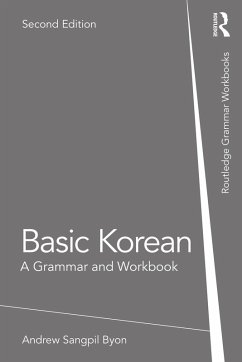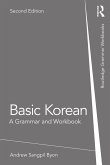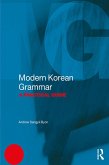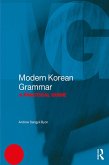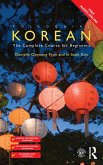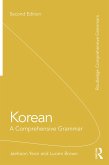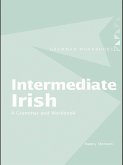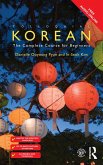39,95 €
39,95 €
inkl. MwSt.
Sofort per Download lieferbar

20 °P sammeln
39,95 €
Als Download kaufen

39,95 €
inkl. MwSt.
Sofort per Download lieferbar

20 °P sammeln
Jetzt verschenken
Alle Infos zum eBook verschenken
39,95 €
inkl. MwSt.
Sofort per Download lieferbar
Alle Infos zum eBook verschenken

20 °P sammeln
- Format: ePub
- Merkliste
- Auf die Merkliste
- Bewerten Bewerten
- Teilen
- Produkt teilen
- Produkterinnerung
- Produkterinnerung

Bitte loggen Sie sich zunächst in Ihr Kundenkonto ein oder registrieren Sie sich bei
bücher.de, um das eBook-Abo tolino select nutzen zu können.
Hier können Sie sich einloggen
Hier können Sie sich einloggen
Sie sind bereits eingeloggt. Klicken Sie auf 2. tolino select Abo, um fortzufahren.

Bitte loggen Sie sich zunächst in Ihr Kundenkonto ein oder registrieren Sie sich bei bücher.de, um das eBook-Abo tolino select nutzen zu können.
Basic Korean: A Grammar and Workbook , Second Edition, is an accessible reference grammar and workbook in one volume. The text can be used in conjunction with any primary textbook, both as a practice book to reinforce learning and as a reference guide to the basics of Korean grammar.
- Geräte: eReader
- mit Kopierschutz
- eBook Hilfe
Andere Kunden interessierten sich auch für
![Basic Korean (eBook, PDF) Basic Korean (eBook, PDF)]() Andrew Sangpil ByonBasic Korean (eBook, PDF)39,95 €
Andrew Sangpil ByonBasic Korean (eBook, PDF)39,95 €![Modern Korean Grammar (eBook, ePUB) Modern Korean Grammar (eBook, ePUB)]() Andrew ByonModern Korean Grammar (eBook, ePUB)49,95 €
Andrew ByonModern Korean Grammar (eBook, ePUB)49,95 €![Modern Korean Grammar (eBook, PDF) Modern Korean Grammar (eBook, PDF)]() Andrew ByonModern Korean Grammar (eBook, PDF)49,95 €
Andrew ByonModern Korean Grammar (eBook, PDF)49,95 €![Colloquial Korean (eBook, ePUB) Colloquial Korean (eBook, ePUB)]() Danielle Ooyoung PyunColloquial Korean (eBook, ePUB)51,95 €
Danielle Ooyoung PyunColloquial Korean (eBook, ePUB)51,95 €![Korean (eBook, ePUB) Korean (eBook, ePUB)]() Jaehoon YeonKorean (eBook, ePUB)54,95 €
Jaehoon YeonKorean (eBook, ePUB)54,95 €![Intermediate Irish: A Grammar and Workbook (eBook, ePUB) Intermediate Irish: A Grammar and Workbook (eBook, ePUB)]() Nancy StensonIntermediate Irish: A Grammar and Workbook (eBook, ePUB)45,95 €
Nancy StensonIntermediate Irish: A Grammar and Workbook (eBook, ePUB)45,95 €![Colloquial Korean (eBook, PDF) Colloquial Korean (eBook, PDF)]() Danielle Ooyoung PyunColloquial Korean (eBook, PDF)51,95 €
Danielle Ooyoung PyunColloquial Korean (eBook, PDF)51,95 €-
-
-
Basic Korean: A Grammar and Workbook, Second Edition, is an accessible reference grammar and workbook in one volume. The text can be used in conjunction with any primary textbook, both as a practice book to reinforce learning and as a reference guide to the basics of Korean grammar.
Dieser Download kann aus rechtlichen Gründen nur mit Rechnungsadresse in A, B, BG, CY, CZ, D, DK, EW, E, FIN, F, GR, HR, H, IRL, I, LT, L, LR, M, NL, PL, P, R, S, SLO, SK ausgeliefert werden.
Produktdetails
- Produktdetails
- Verlag: Taylor & Francis eBooks
- Seitenzahl: 230
- Erscheinungstermin: 16. Dezember 2020
- Englisch
- ISBN-13: 9781000258912
- Artikelnr.: 60538099
- Verlag: Taylor & Francis eBooks
- Seitenzahl: 230
- Erscheinungstermin: 16. Dezember 2020
- Englisch
- ISBN-13: 9781000258912
- Artikelnr.: 60538099
- Herstellerkennzeichnung Die Herstellerinformationen sind derzeit nicht verfügbar.
Andrew Sangpil Byon is Associate Professor of Korean Studies at the State University of New York at Albany, USA.
1 Hangul (the Korean alphabet) 2 Characteristics of the Korean language 3 Nouns 4 Predicates and endings 5 The formal speech level and the polite speech level 6 The subject case particle
/
7 The special particle
/
8 Pronouns 9 Numbers, ordinals, and plural marker
10 Counters, the question word
, and some time expressions 11 The copula
/
and the verb of existence and location
/
12 Case particles I:
/
and (
)
13 Case particles II:
,
,
/
, (
)
, and
14 Case particles III:
,
,
,
,
, and
15 Special particles I :
and
16 Special particle II: (
)
,
, and
17 Past tense and double past tense marker 18 Negation 19 Irregular predicates 20 Expressing desire ~
, continuous actions ~
, and continuous states ~
/
21 The endings: ~(
)
and ~(
)
? 22 Prenouns 23 Adverbs and adverbials 24 The endings: ~(
)
and ~(
)
25 The suffixes: ~
and -(
)
26 Sentence-final endings: ~
, ~
, ~
, ~
/
7 The special particle
/
8 Pronouns 9 Numbers, ordinals, and plural marker
10 Counters, the question word
, and some time expressions 11 The copula
/
and the verb of existence and location
/
12 Case particles I:
/
and (
)
13 Case particles II:
,
,
/
, (
)
, and
14 Case particles III:
,
,
,
,
, and
15 Special particles I :
and
16 Special particle II: (
)
,
, and
17 Past tense and double past tense marker 18 Negation 19 Irregular predicates 20 Expressing desire ~
, continuous actions ~
, and continuous states ~
/
21 The endings: ~(
)
and ~(
)
? 22 Prenouns 23 Adverbs and adverbials 24 The endings: ~(
)
and ~(
)
25 The suffixes: ~
and -(
)
26 Sentence-final endings: ~
, ~
, ~
, ~
1 Hangul (the Korean alphabet) 2 Characteristics of the Korean language 3 Nouns 4 Predicates and endings 5 The formal speech level and the polite speech level 6 The subject case particle / 7 The special particle / 8 Pronouns 9 Numbers, ordinals, and plural marker 10 Counters, the question word , and some time expressions 11 The copula / and the verb of existence and location / 12 Case particles I: / and ( ) 13 Case particles II: , , / , ( ) , and 14 Case particles III: , , , , , and 15 Special particles I : and 16 Special particle II: ( ) , , and 17 Past tense and double past tense marker 18 Negation 19 Irregular predicates 20 Expressing desire ~ , continuous actions ~ , and continuous states ~ / 21 The endings: ~( ) and ~( ) ? 22 Prenouns 23 Adverbs and adverbials 24 The endings: ~( ) and ~( ) 25 The suffixes: ~ and -( ) 26 Sentence-final endings: ~ , ~ , ~ , ~
1 Hangul (the Korean alphabet) 2 Characteristics of the Korean language 3 Nouns 4 Predicates and endings 5 The formal speech level and the polite speech level 6 The subject case particle
/
7 The special particle
/
8 Pronouns 9 Numbers, ordinals, and plural marker
10 Counters, the question word
, and some time expressions 11 The copula
/
and the verb of existence and location
/
12 Case particles I:
/
and (
)
13 Case particles II:
,
,
/
, (
)
, and
14 Case particles III:
,
,
,
,
, and
15 Special particles I :
and
16 Special particle II: (
)
,
, and
17 Past tense and double past tense marker 18 Negation 19 Irregular predicates 20 Expressing desire ~
, continuous actions ~
, and continuous states ~
/
21 The endings: ~(
)
and ~(
)
? 22 Prenouns 23 Adverbs and adverbials 24 The endings: ~(
)
and ~(
)
25 The suffixes: ~
and -(
)
26 Sentence-final endings: ~
, ~
, ~
, ~
/
7 The special particle
/
8 Pronouns 9 Numbers, ordinals, and plural marker
10 Counters, the question word
, and some time expressions 11 The copula
/
and the verb of existence and location
/
12 Case particles I:
/
and (
)
13 Case particles II:
,
,
/
, (
)
, and
14 Case particles III:
,
,
,
,
, and
15 Special particles I :
and
16 Special particle II: (
)
,
, and
17 Past tense and double past tense marker 18 Negation 19 Irregular predicates 20 Expressing desire ~
, continuous actions ~
, and continuous states ~
/
21 The endings: ~(
)
and ~(
)
? 22 Prenouns 23 Adverbs and adverbials 24 The endings: ~(
)
and ~(
)
25 The suffixes: ~
and -(
)
26 Sentence-final endings: ~
, ~
, ~
, ~
1 Hangul (the Korean alphabet) 2 Characteristics of the Korean language 3 Nouns 4 Predicates and endings 5 The formal speech level and the polite speech level 6 The subject case particle / 7 The special particle / 8 Pronouns 9 Numbers, ordinals, and plural marker 10 Counters, the question word , and some time expressions 11 The copula / and the verb of existence and location / 12 Case particles I: / and ( ) 13 Case particles II: , , / , ( ) , and 14 Case particles III: , , , , , and 15 Special particles I : and 16 Special particle II: ( ) , , and 17 Past tense and double past tense marker 18 Negation 19 Irregular predicates 20 Expressing desire ~ , continuous actions ~ , and continuous states ~ / 21 The endings: ~( ) and ~( ) ? 22 Prenouns 23 Adverbs and adverbials 24 The endings: ~( ) and ~( ) 25 The suffixes: ~ and -( ) 26 Sentence-final endings: ~ , ~ , ~ , ~
